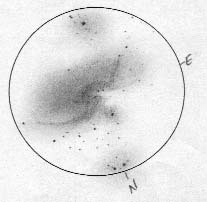 M42, The Orion Nebula, is arguably the greatest celestial treasure available to observers in mid-northern latitudes. You will find it in the hilt of Orion's sword just a few degrees below the three, bright belt stars. But the object we're after resides nearby to the south. The sketch at left is based on a 36X view in my 10-inch equatorial mount Newtonian. M42 spans 70'x40', more than twice the size of the full Moon. It features expansive wings sweeping east and west. Messier 43, the nebulous comma patch surrounding the 8th magnitude star immediately to the north, dangles from M42 like an ornament. NGC 1980 is visible about half-a-degree south of the great Orion Nebula, just inside the southern field boundary. At the heart of this combination open star cluster/emission nebula, is 2.8 magnitude Iota Orionis. The O-type giant is enmeshed within a delicate misty glow some 15' in diameter. The handful of stars in the immediate vicinity are all members of the cluster, including a bright pair of 5th and 6th magnitude sparklers shining About 8' southeast of Iota Orionis. Observers with large aperture should seek out the nearby Rosette Nebula, an equally stunning gem of the winter sky.
M42, The Orion Nebula, is arguably the greatest celestial treasure available to observers in mid-northern latitudes. You will find it in the hilt of Orion's sword just a few degrees below the three, bright belt stars. But the object we're after resides nearby to the south. The sketch at left is based on a 36X view in my 10-inch equatorial mount Newtonian. M42 spans 70'x40', more than twice the size of the full Moon. It features expansive wings sweeping east and west. Messier 43, the nebulous comma patch surrounding the 8th magnitude star immediately to the north, dangles from M42 like an ornament. NGC 1980 is visible about half-a-degree south of the great Orion Nebula, just inside the southern field boundary. At the heart of this combination open star cluster/emission nebula, is 2.8 magnitude Iota Orionis. The O-type giant is enmeshed within a delicate misty glow some 15' in diameter. The handful of stars in the immediate vicinity are all members of the cluster, including a bright pair of 5th and 6th magnitude sparklers shining About 8' southeast of Iota Orionis. Observers with large aperture should seek out the nearby Rosette Nebula, an equally stunning gem of the winter sky. |
![]()
![]()
